This may well be the latest-ever 2012 end of the year listing. Sorry, but I’ve found that as I get older reading time grows increasingly difficult to come by. That’s a shame, as publishing-wise 2012 contained more than its share of good, and sometimes even great, books.
To be sure, there were quite a few publications I wanted to read in 2012 but just didn’t get to (including Graham Joyce’s SOME KIND OF FAIRY TALE, Ramsey Campbell’s THE KIND FOLK and Stephen King’s THE WIND THROUGH THE KEYHOLE). At least I was able to finally get around to reading several 2011 publications I missed out on last year, which is the reason for the “Worthwhile 2011 Publications I Missed” listing near the end of this piece.
This time around, you’ll find, I’m dispensing with my usual groupings in favor of four categories—“The Great,” “The Good,” “Everything Else” and the abovementioned “Worthwhile 2011 Publications I Missed.” So with that in mind let’s get started with…
The Great
 My favorite horror novel of 2012? That’s easy: it’s the Thomas Dunne Books published LITTLE STAR by Sweden’s JOHN AJVIDE LINDQVIST (of LET THE RIGHT ONE IN and HANDLING THE UNDEAD), which is horror fiction as it should be: unashamedly dark, challenging and compelling.
My favorite horror novel of 2012? That’s easy: it’s the Thomas Dunne Books published LITTLE STAR by Sweden’s JOHN AJVIDE LINDQVIST (of LET THE RIGHT ONE IN and HANDLING THE UNDEAD), which is horror fiction as it should be: unashamedly dark, challenging and compelling.
It begins with the aging singer Lennart discovering an infant girl left for dead in a forest. The girl possesses a near-angelic singing voice, which impresses Lennart mightily. He and his wife decide to surreptitiously raise the girl, who they christen Theres, away from the eyes of authorities. This has the effect of further stunting the girl’s already damaged psyche, and at age 12 she commits a horrific act of violence—the first of several, as it turns out.
Theres ends up in the care of her older brother Jerry, who exploits her singing talents in a most unexpected manner: he enters her in the Swedish equivalent of AMERICAN IDOL. Among the viewers of the program is 12-year-old Theresa, a borderline sociopath who feels an immediate kinship with Theres. The two meet via Twitter, and form a disturbing bond that can only lead to bad things, especially when a pedophile music promoter enters the picture and Theres uses Twitter to gather together a mini-gang of pubescent adherents.
All these elements play a role in the profoundly bleak and nasty finale, which forcibly demonstrates just how fearless Lindqvist is in following his material to its darkest extremes. The narrative never plays it safe (there’s no police inquest or romance to leaven the horror) and is never less than entirely convincing in its rendering of modern teen girls whose existence is defined by reality TV and social media. Yet like all successful novels LITTLE STAR works ultimately because it tells a damn good story, and does so in consistently absorbing and surprising fashion.
Another great 2012 publication was MY FRIEND DAHMER (Abrams ComicArts), a graphic novel written and 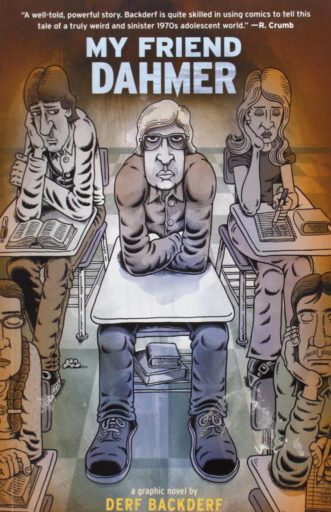 illustrated by DERF BACKDERF. Backderf attended Ohio’s Revere High School with serial killer Jeffrey Dahmer in the late 1970s, an experience that as depicted in this book wasn’t too different from what most of the rest of us experienced in our own adolescent years. We all knew a weird kid with limited social skills who was treated as an object of merriment by his classmates, and about whom you might have subsequently claimed (as Backderf depicts himself jokingly stating near of the end of this book) “he’s probably a serial killer by now.”
illustrated by DERF BACKDERF. Backderf attended Ohio’s Revere High School with serial killer Jeffrey Dahmer in the late 1970s, an experience that as depicted in this book wasn’t too different from what most of the rest of us experienced in our own adolescent years. We all knew a weird kid with limited social skills who was treated as an object of merriment by his classmates, and about whom you might have subsequently claimed (as Backderf depicts himself jokingly stating near of the end of this book) “he’s probably a serial killer by now.”
It’s that sense of universality that makes this such a profoundly unsettling read. The adolescent environment it depicts is thoroughly ordinary, yet turns out to be a perfect breeding ground for Dahmer’s murderous psychosis. Backderf’s idiosyncratic artwork, with its Don Martin-esque square-headed figures, lends the proceedings a striking sense of weirdness, and also excels in cinematic storytelling of the type that distinguishes all truly great graphic novels.
As portrayed herein, Dahmer was a severely screwed-up young man acted out for his classmates by faking epileptic seizures. What those classmates didn’t know was that Jeff masturbated to images of mutilated cadavers and lovingly dismembered dead animals in his spare time. His mental state wasn’t helped by his neglectful parents, who were in the midst of an extremely acrimonious divorce, nor his equally clueless teachers. The book concludes with Dahmer’s first killing, which Backderf portrays as the inevitable outgrowth of the suburban existence he and Dahmer lived—as do quite a few of the rest of us.
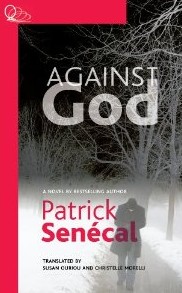 AGAINST GOD (Quattro Books), the first-ever English translation of the work of Quebec’s PATRICK SENECAL, was another standout ‘12 publication. It’s a propulsive depiction of grief and madness, experienced by a 35-year-old man who’s just lost his family.
AGAINST GOD (Quattro Books), the first-ever English translation of the work of Quebec’s PATRICK SENECAL, was another standout ‘12 publication. It’s a propulsive depiction of grief and madness, experienced by a 35-year-old man who’s just lost his family.
It should be mentioned that the form of AGAINST GOD is as important as the narrative. The entire novel is related in a single sentence, interspaced with (but never broken by) italicized dialogue exchanges. Far from the type of pretentious treatment you might expect, this gives the tale a breathless intensity appropriate to the simmering mindset of its protagonist. As for the narrative voice, it’s frank, unshowy and related in the second person, although it occasionally lapses into the first (from “You” to “I”)—and on those occasions it’s not the protagonist whose voice is being intoned.
Said protagonist is stunned when cops show up on his doorstep one morning and announce that his wife and children have been killed in a car accident. He’s unable to process the information, and in the first of many bizarre acts pushes a wheelchair-bound relative into the middle of a busy street. From there he impulsively picks up a young woman in a restaurant, gets in a car accident, buys and then throws away a ton of DVDs, rents a new apartment and picks up another woman, who he kills in an irrational fit.
The above covers roughly the book’s first half. You can be sure that further killings are in store as the protagonist’s rage and disillusionment increase, and the novel’s true narrator finally identifies Himself. The ending, as I’m sure you’ve guessed, is anything but happy.
RAISING HELL: KEN RUSSELL AND THE UNMAKING OF THE DEVILS by RICHARD CROUSE (ECW Press) is  in my view one of the few truly essential movie making-of books, seeing as how it tells the story of one of the most remarkable films of the 1970s: Ken Russell’s delirious 1971 masterpiece THE DEVILS. That film has been profiled a fair amount over the years (see the BBC documentary HELL ON EARTH), but the full story of its conception, filming and ultimate undoing has remained untold until now.
in my view one of the few truly essential movie making-of books, seeing as how it tells the story of one of the most remarkable films of the 1970s: Ken Russell’s delirious 1971 masterpiece THE DEVILS. That film has been profiled a fair amount over the years (see the BBC documentary HELL ON EARTH), but the full story of its conception, filming and ultimate undoing has remained untold until now.
As recorded in this book, the making of THE DEVILS was nearly as outrageous as the film itself, with scenes of near-pornographic outrage that apparently took quite a toll on the performers, all taking place amid a plethora of amazing sets designed by future filmmaker Derek Jarman and subject to the mood swings of the famously mercurial Russell. The true outrage, however, is what occurred after shooting was completed. Warner Brothers execs ordered a mass of post production edits, including that of one of the film’s most important scenes, the so-called “Rape of Christ” sequence that was removed from all prints of THE DEVILS. Even today the film exists only in mutilated form, with an uncut print allegedly existing somewhere in the Warner Brothers studio vaults that Warner executives steadfastly refuse to release.
Author Richard Crouse relates this strange and maddening saga in engaging and user-friendly fashion, with quite a few revealing anecdotes about the film and the controversy it inspired. You may think, as I did, that you knew everything there was to know about THE DEVILS, but with this book Richard Crouse unquestionably has the last word.
The Good
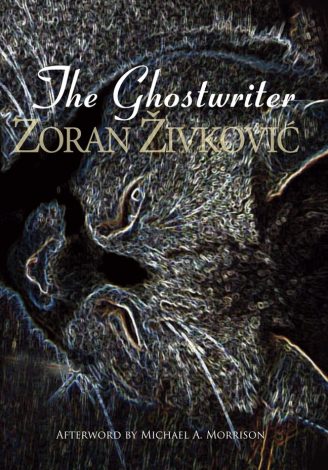 THE GHOSTWRITER, from PS Publishing, is the latest novel by Serbia’s always unpredictable ZORAN ZIVKOVIC. It’s a short novel whose premise is quite simple, involving an unnamed writer answering emails. Yet in true Zivkovic fashion the proceedings, deceptively uneventful though they may be, come to explore profound questions about creativity, authorship and identity.
THE GHOSTWRITER, from PS Publishing, is the latest novel by Serbia’s always unpredictable ZORAN ZIVKOVIC. It’s a short novel whose premise is quite simple, involving an unnamed writer answering emails. Yet in true Zivkovic fashion the proceedings, deceptively uneventful though they may be, come to explore profound questions about creativity, authorship and identity.
As the novel opens the aforementioned author, suffering from writer’s block, receives an email from “An Admirer” requesting that the writer ghostwrite a novel for him and turn over all authorship rights. The writer’s response to this request is interrupted by four other email correspondents, each with equally eccentric, and weirdly similar, queries. First is OpenSea, a pretentious novelist who likes to needle the writer, telling him he should write a self-parody. Then there’s Banana, a female fan who’s attempting to string her dreams together into a novel (of sorts) that she wants the writer to help her finish. There’s also P-0, who likes to compose self-described “pastiches” of the writer’s stories, and now seeks to reverse the process by writing the pastiche first. Finally we have the aging Pandora, who entreats the writer to draft a novel about her dying pooch Albert.
Of course I’m quite aware that the above might seem to make THE GHOSTWRITER out to be an example of the type of postmodern gobbledygook that afflicts a lot of today’s fiction, and which quite a few readers (this one included) go out of their way to avoid. In truth, however, the novel, like all of Zoran Zivkovic’s fiction, is eminently readable and a lot of fun.
GRAVEYARD SPECTRES (Elektron Ebooks) by Belgium’s late JEAN RAY is a slim five story ebook that collects 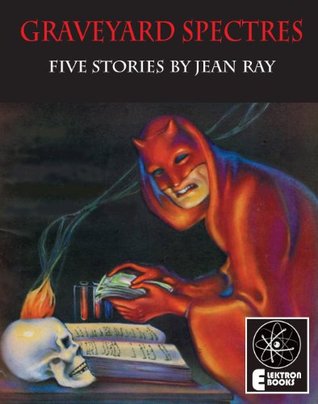 five Ray stories. They include “The Shadowy Street” (also known as “The Tenebrous Alley”), which is widely acclaimed as Ray’s masterpiece. It’s a novella length account of considerable daring and ingenuity, pivoting on two linked narrative strands. In the first a family finds that their home is haunted by invisible presences, and in the second a young man discovers a mysterious alleyway only he can see; eventually he ventures into the alley, and what he finds demonstrates Ray’s considerable flair for surrealistic apprehension–and, in the apocalyptic final passages, outright horror. Of a similar hue is “The Mainz Psalter,” about a ship besieged by otherworldly creatures that favorably recalls William Hope Hodgson’s classic tales of sea-bound horror, but marked by Ray’s unmistakable mix of old school apprehension and 20th Century surrealism. Taken as a whole this slight publication is far from ideal for horror buffs wanting a full representation of Jean Ray’s peculiar genius, but since Ray’s other English language publications are extremely difficult to obtain GRAVEYARD SPECTRES gets a default recommendation.
five Ray stories. They include “The Shadowy Street” (also known as “The Tenebrous Alley”), which is widely acclaimed as Ray’s masterpiece. It’s a novella length account of considerable daring and ingenuity, pivoting on two linked narrative strands. In the first a family finds that their home is haunted by invisible presences, and in the second a young man discovers a mysterious alleyway only he can see; eventually he ventures into the alley, and what he finds demonstrates Ray’s considerable flair for surrealistic apprehension–and, in the apocalyptic final passages, outright horror. Of a similar hue is “The Mainz Psalter,” about a ship besieged by otherworldly creatures that favorably recalls William Hope Hodgson’s classic tales of sea-bound horror, but marked by Ray’s unmistakable mix of old school apprehension and 20th Century surrealism. Taken as a whole this slight publication is far from ideal for horror buffs wanting a full representation of Jean Ray’s peculiar genius, but since Ray’s other English language publications are extremely difficult to obtain GRAVEYARD SPECTRES gets a default recommendation.
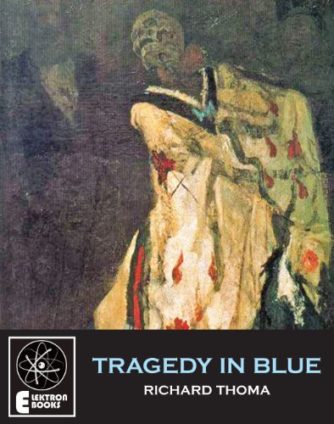 The fearsome figure of the 15th Century French child killer Gilles de Rais continues to exert an enduring fascination. Rais was a fiercely multifaceted individual, fighting alongside Joan of Arc as a commander in the French army and later dabbling in necromancy before killing dozens—possibly even hundreds—of children. TRAGEDY IN BLUE by RICHARD THOMA (Elektron Ebooks) takes a highly florid and poetic approach in this tragic tale.
The fearsome figure of the 15th Century French child killer Gilles de Rais continues to exert an enduring fascination. Rais was a fiercely multifaceted individual, fighting alongside Joan of Arc as a commander in the French army and later dabbling in necromancy before killing dozens—possibly even hundreds—of children. TRAGEDY IN BLUE by RICHARD THOMA (Elektron Ebooks) takes a highly florid and poetic approach in this tragic tale.
Thoma follows the particulars of Rais’ life fairly closely, but this is a psychologically centered account less concerned with historical detail than with its subject’s ever-shifting mental state. It begins with Rais as a young adult joining the cause of Joan of Arc. He’s immediately struck by her boyish figure and near-messianic conviction, yet has a presentiment that she’s not long for this Earth. He grows perversely determined to be the Judas to Joan’s Christ, yet when she’s executed Rais is devastated.
Rais’ subsequent descent into murderous insanity is carefully and convincingly laid out in fairly graphic (but never gratuitously so) detail. The most disturbing portion of the novel arguably occurs in the final pages, in which Thoma alleges, without a trace of irony, that Rais’ newfound religious conviction fully redeems him in the eyes of God. Truly, if any human being can be said to be irredeemable it’s Gilles de Rais, and I’m not sure that Richard Thoma, despite the undeniable beauty of his prose and keen psychological insight, makes a convincing case for the contrary.
MINSKI THE CANNIBAL by MARQUIS DE SADE (Elektron Ebooks) is an extended except from Sade’s 1200 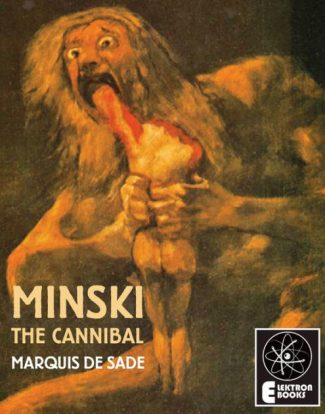 pages opus JULIETTE, in which the eponymous Juliette, having escaped a debauched convent and devoted her life to evil, happens upon Minski, a giant ogre who lives in a secluded seaside cave. He’s stocked the place with slaves who kidnap hordes of young people for the amoral Minski to butcher and devour. All he eats is human flesh taken from the countless people he kills, accomplished through a complex system of torture apparatuses. Juliette loses two of her companions to Minski’s depraved lusts and, even worse, is forced to listen to him lecture interminably about the joys of debauchery. Eventually Juliette turns Minski’s philosophies against him by drugging the asshole and making off with much of his fortune.
pages opus JULIETTE, in which the eponymous Juliette, having escaped a debauched convent and devoted her life to evil, happens upon Minski, a giant ogre who lives in a secluded seaside cave. He’s stocked the place with slaves who kidnap hordes of young people for the amoral Minski to butcher and devour. All he eats is human flesh taken from the countless people he kills, accomplished through a complex system of torture apparatuses. Juliette loses two of her companions to Minski’s depraved lusts and, even worse, is forced to listen to him lecture interminably about the joys of debauchery. Eventually Juliette turns Minski’s philosophies against him by drugging the asshole and making off with much of his fortune.
I’ll give Elektron Ebooks credit for publishing this fragment as a standalone work, as I find JULIETTE to be largely unreadable. MINSKI, by contrast, is like the entire novel compressed into 40 pages: bold, shocking, not a little implausible (how is it that Minski manages to kill so many people without anyone noticing?) and eventually bogging down in a morass of dull philosophizing. Also included is an essay on de Sade’s relation to the gothic novel, with comparisons to the works of Radcliffe, Matthew Lewis and Horace Walpole.
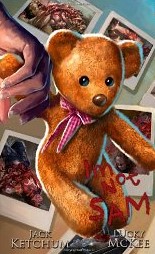 I’M NOT SAM (Sinister Grin Press) is the latest offering from the great JACK KETCHUM, written in collaboration with filmmaker LUCKY McKEE. The book suffers somewhat from being a short story stretched to novella length (with all the noticeable flaws that entails) and the fact that its premise isn’t terribly original (see the Nicole Kidman film BIRTH and the Keigo Higashino novel NOAKO), yet no Jack Ketchum effort is entirely unworthy.
I’M NOT SAM (Sinister Grin Press) is the latest offering from the great JACK KETCHUM, written in collaboration with filmmaker LUCKY McKEE. The book suffers somewhat from being a short story stretched to novella length (with all the noticeable flaws that entails) and the fact that its premise isn’t terribly original (see the Nicole Kidman film BIRTH and the Keigo Higashino novel NOAKO), yet no Jack Ketchum effort is entirely unworthy.
I’M NOT SAM is far more subdued overall than we’ve come to expect from either Ketchum or McKee, but it works reasonably well. It’s divided into two distinct sections, the first of which, “I’m Not Sam,” is told from the point of view of Patrick, a comic book artist who lives with his surgeon wife Samantha. One night after screwing her Patrick awakens to find that Sam has inexplicably taken to acting like a child, and now answers to the name Lily. The unfortunate thing is that he still lusts after his wife, which given her new childlike persona feels perverse; nonetheless, Patrick can’t help but act on his desires, which provides the “I’m Not Sam” section of the book with its blunt conclusion. The final lines aren’t as shocking as Ketchum and McKee appear to have intended—not quite the “single punch to the gut” Ketchum promises in the introduction—but are still fairly impacting.
“I’m Not Lily” is the second of the book’s two sections. Much shorter than the first, it’s told from the point of view of Samantha, who’s now herself once again and attempting to figure out what occurred over the past two and a half weeks. As with the first section, this one ends with something of a shock, but a far deeper and more measured one that closes out “I’m Not Lily,” and the book as a whole, on a satisfying note.
A GLIMPSE OF THE NUMINOUS by JEFF GARDINER (Eibonvale) consists of fourteen stories that evince a 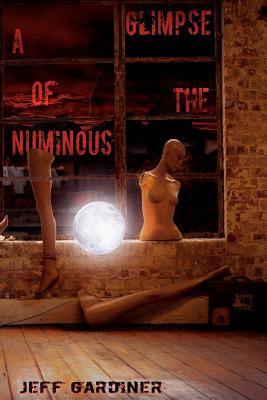 startling range of styles and subject matter.
startling range of styles and subject matter.
The title story is a perversely erotic piece about a man who finds himself aroused by the spectacle of his wife masturbating in bed each morning…until he discovers that something else is in bed with them! “351073” is even stranger, a bleakly comedic account of a girl named 351073, which has the unfortunate effect of instilling an obsession with numerology that leads her into believing she’s a messiah (because that’s how her life numbers add up). Then there’s the profoundly chilling “Bred in the Bone,” a recollection of a seemingly normal childhood that as the story advances reveals itself as anything but normal.
Of an entirely different, more reality-based hue is “More Sinned Against,” in which a budding relationship between a man and woman is abruptly derailed when the woman undergoes a sudden religious conversion. The situation plays out with an unmistakable ring of truth, and offers no easy answers.
Inevitably there are some less-than-good pieces—notably the obvious and predictable “Withdrawal” and the overwrought “Writer’s Block”—yet A GLIMPSE OF THE NUMINOUS overall must be counted as a success, showcasing a new writer from whom I believe we’ll unquestionably be hearing great things.
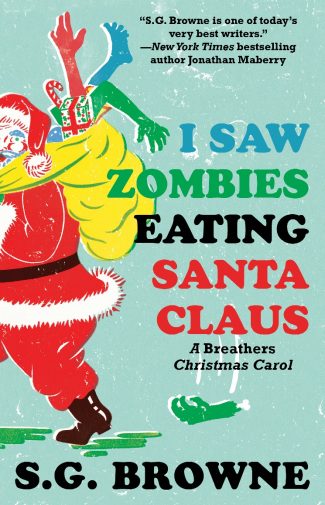 I SAW ZOMBIES EATING SANTA CLAUS by S.G. BROWNE (Gallery Books) is a sequel to Browne’s comedic zombie epic BREATHERS. I haven’t read that novel, yet I SAW ZOMBIES EATING SANTA CLAUS works well enough as a standalone narrative, being funny, gory and even touching—just as you’d expect from a Christmas-themed zombie mash.
I SAW ZOMBIES EATING SANTA CLAUS by S.G. BROWNE (Gallery Books) is a sequel to Browne’s comedic zombie epic BREATHERS. I haven’t read that novel, yet I SAW ZOMBIES EATING SANTA CLAUS works well enough as a standalone narrative, being funny, gory and even touching—just as you’d expect from a Christmas-themed zombie mash.
Andy is a personable and kind-hearted zombie who escapes from an Oregon research facility around Christmastime. To throw off the researchers on his tail Andy dons a Santa Claus costume, which goes well with his white beard, and takes on unexpected significance when he encounters a “breather” girl named Annie. The latter is stuck with a neglectful mother who ignores Christmas, and all Annie truly wants is for her ma to pay her more attention; against his better instincts Andy, playing up his Santa Claus guise, agrees to give Annie what she wants.
I enjoyed this book, even if zombie fiction has, as far as I’m concerned, officially been done to death. Nor am I terribly fond of the type of overtly comedic Christopher Moore-esque prose that suffuses this novel. What redeemed it for me was the touching dynamic between the protagonist and sweet little Annie, which is quite moving almost in spite of itself.
ZONA: A BOOK ABOUT A FILM ABOUT A JOURNEY TO A ROOM by GEOFF DYER (Vintage) is certainly one  of the most idiosyncratic film studies I’ve ever encountered. The subject is Andrei Tarkovsky’s Russian sci fi-art film STALKER, with which author Geoff Dyer is admittedly obsessed. That obsession here takes the form of an exhaustive scene-by-scene analysis of the film, which is anything but the dry and over-intellectualized tripe that typifies this sort of book.
of the most idiosyncratic film studies I’ve ever encountered. The subject is Andrei Tarkovsky’s Russian sci fi-art film STALKER, with which author Geoff Dyer is admittedly obsessed. That obsession here takes the form of an exhaustive scene-by-scene analysis of the film, which is anything but the dry and over-intellectualized tripe that typifies this sort of book.
Dyer’s account, in fact, is unerringly lively, clever and wide-ranging, packed with incredibly lengthy footnotes that contain innumerable philosophical digressions, humorous recollections and tidbits about the filming and reception of STALKER that prove the author has done his homework. Numerous books and documentaries about Tarkovsky and STALKER are referenced, as are personal interviews Dyer conducted with various Tarkovsky acquaintances (my favorite being a recollection by Telluride Film Festival co-director Tom Luddy, who claims that Tarkovsky, upon seeing Utah’s Monument Valley, said that Americans were “vulgar and materialistic” to film Westerns in such beautiful scenery, which was suitable only for films about God).
I’ll confess I disagreed with many of Dyer’s conclusions, yet my own history with STALKER is very similar to his (as described here, at least), in that I didn’t think much of the film the first time I saw it yet found over the following years that its imagery had taken ineffable root in my subconscious. This, of course, brings up the fact that only diehard fans of STALKER will fully respond to this book, but if you happen to fall into that group than this is required reading pure and simple.
…And The Rest
 In HELL TRAIN (Solaris) England’s CHRISTOPHER FOWLER, who of late has focused largely on contemporary whodunits, returns to the genre that made his name. The novel centers on an American screenwriter who goes to work for England’s Hammer Studios in 1966, scripting a movie about an evil train that’s set to star Christopher Lee and Peter Cushing. Much of the remainder of the book is taken up with the particulars of that screenplay, related in novel form.
In HELL TRAIN (Solaris) England’s CHRISTOPHER FOWLER, who of late has focused largely on contemporary whodunits, returns to the genre that made his name. The novel centers on an American screenwriter who goes to work for England’s Hammer Studios in 1966, scripting a movie about an evil train that’s set to star Christopher Lee and Peter Cushing. Much of the remainder of the book is taken up with the particulars of that screenplay, related in novel form.
The year of the story-within-the-story is 1916. The central characters include an adventurer afoot in Poland, a Polish babe fleeing her stifling family life, a country priest and the latter’s dissatisfied wife. All have the misfortune of boarding the Arkangel, a train whose ultimate destination is signified by the book’s title. Innumerable macabre shenanigans, presided over by an inhuman conductor, are in store, including internment in a coffin, dismemberment, a mutant insect attack and more.
My favorite parts of HELL TRAIN were the chapters set in the story without, in which the screenwriter protagonist meets with Hammer’s overseers and plans out the prospective film. That film was of course never made, a fact I don’t much regret, as this novel is a diverting enough bit of grade-B mayhem but not much else.
I’ll give REEL TERROR (Thomas Dunne Books), in which author DAVID KONOW attempts to chronicle the entire 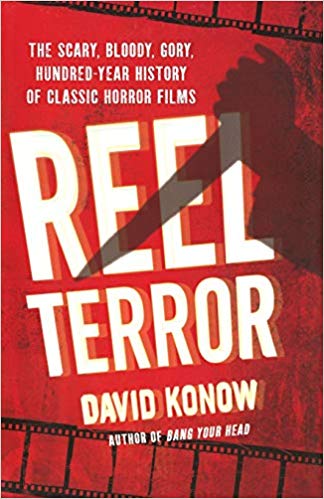 100-plus year history of horror cinema, points for ambition. I’ll also give Konow a nod for keeping his facts straight, since, speaking as one who knows more than a bit about classic and current horror cinema, I didn’t detect too many factual errors. Unfortunately those are about the only nice things I can say about this book.
100-plus year history of horror cinema, points for ambition. I’ll also give Konow a nod for keeping his facts straight, since, speaking as one who knows more than a bit about classic and current horror cinema, I didn’t detect too many factual errors. Unfortunately those are about the only nice things I can say about this book.
REEL CINEMA’S biggest failing? Simply that the history of horror cinema cannot be adequately chronicled in this book’s 536 pages. Immortal films like FRANKENSTEIN, DRACULA, THE EXORCIST, HALLOWEEN, ALIEN, THE SILENCE OF THE LAMBS and THE BLAIR WITCH PROJECT are covered with a fair amount of info on the films’ making and reception, yet just as much is left out of this book. The AIP drive-in movies of the sixties are mentioned only in passing, as is virtually the entire genre output of the 00’s, while such classics as the 1910 FRANKENSTEIN, EYES WITHOUT A FACE, CARNIVAL OF SOULS and BASKET CASE aren’t mentioned at all. The book is also top-heavy with coverage on films from the 1970s and 80s, with comparatively little on the preceding sixty years or the proceeding twenty.
Finally, and perhaps most grievously, I’ll have to complain about David Konow’s noticeably flat and listless prose style. A little more enthusiasm would have been welcome, as would some of the redeeming quirkiness of classic nonfiction tomes like Drake Douglas’ HORROR and Kim Newman’s NIGHTMARE MOVIES. Those books admittedly share many of the same flaws that plague this one, but both are distinguished by a real sense of passion and audacity, qualities REEL TERROR sorely lacks.
Worthwhile 2011 Publications I Missed Last Year
 FEATHER: TALES OF ISOLATION AND DESCENT by DAVID RIX (Eibonvale) is a true oddity that exists somewhere in the arena of J.G. Ballard and Ian Sinclair, yet will never be mistaken for anything other than itself. I should add that the amazing wraparound cover art, created by the book’s author David Rix, deserves some kind of award for evocative book design. Depicting a woman’s face half buried in sand, said cover art perfectly captures the air of wistful surrealism that pervades the text.
FEATHER: TALES OF ISOLATION AND DESCENT by DAVID RIX (Eibonvale) is a true oddity that exists somewhere in the arena of J.G. Ballard and Ian Sinclair, yet will never be mistaken for anything other than itself. I should add that the amazing wraparound cover art, created by the book’s author David Rix, deserves some kind of award for evocative book design. Depicting a woman’s face half buried in sand, said cover art perfectly captures the air of wistful surrealism that pervades the text.
It centers on Feather, a teenage girl who assumes the lead role in the opening story “The Tiny Window on River Street.” “Yellow Eyes” follows, in which Feather resides in a secluded shack with her hippie father, who lives in fear of someone he calls The Measuring Man. At a couple points Feather experiences vividly described dreams; this is significant, as dreams become increasingly prevalent as the book advances.
In “The Angels” and “The Book of Tides” Feather is the houseguest of two disturbed writers who each live by the sea, and who are both impacted irrevocably by her presence. In “The Magpies” Feather emails the unstable Elizabeth, whose mental state isn’t helped at all by an unidentified potion Feather sends her. The novella length “To Call the Sea” is an alternately beautiful and maddening piece involving a haunted dorm and all the sand, sea and dream imagery so integral to the book’s overall atmosphere. In an “Endword” entitled “The Sea Train,” David Rix himself assumes the lead role, regretting that he left Feather so unsettled in the preceding pages yet finding himself powerless to alter her destiny.
AUTOMATIC SAFE DOG (Eibonvale) was the first novel by the English writer and musician JET McDONALD. In it  we’re introduced to the burgeoning industry of Pet Furnishing, a practice that began with a dog whose owners for some reason sawed off its legs and replaced them with castors. From this grew a lucrative retail niche, with warehouses springing up throughout England dedicated to turning dogs into furniture. The protagonist Telby (as in Terribly) works as a dog comber in one of those warehouses, where he falls in love with his fetching boss Ravenski. Unfortunately Telby is fired after he and Ravenski break the back of a dog bench by sitting on it together. Telby, however, is still hot for Ravenski, and somehow cons his ways into Pet Furnishings’ corporate elite, where rabies induced sex sprees, testicular transplants and disembodied vaginas are the order of the day.
we’re introduced to the burgeoning industry of Pet Furnishing, a practice that began with a dog whose owners for some reason sawed off its legs and replaced them with castors. From this grew a lucrative retail niche, with warehouses springing up throughout England dedicated to turning dogs into furniture. The protagonist Telby (as in Terribly) works as a dog comber in one of those warehouses, where he falls in love with his fetching boss Ravenski. Unfortunately Telby is fired after he and Ravenski break the back of a dog bench by sitting on it together. Telby, however, is still hot for Ravenski, and somehow cons his ways into Pet Furnishings’ corporate elite, where rabies induced sex sprees, testicular transplants and disembodied vaginas are the order of the day.
In the category of surreal comedy this crazed fantasy is a standout. Not all of it works (even in a surreal universe Telby’s rise through Pet Furnishings’ corporate ranks is hopelessly implausible) yet Jet McDonald’s satire is quite pertinent in its exploration of corporate psychopathology, artistic pretension and the power of love. The novel will surely upset just as many readers as it enchants, yet in today’s economy-devouring corporate culture I believe Jet McDonald’s altogether outrageous brand of absurdity is exactly what we need.
 There’s never been a time travel account quite like THE SILVER WIND by NINA ALLAN (Eibonvale). It’s a collection of five standalone stories, all with definite links. This to say that several characters recur in varying guises and time frames, with a mysterious watch turning up in each tale and causing all sorts of odd disruptions. Yet what ultimately makes these stories sing is the author’s unerringly observant, character-driven writing style.
There’s never been a time travel account quite like THE SILVER WIND by NINA ALLAN (Eibonvale). It’s a collection of five standalone stories, all with definite links. This to say that several characters recur in varying guises and time frames, with a mysterious watch turning up in each tale and causing all sorts of odd disruptions. Yet what ultimately makes these stories sing is the author’s unerringly observant, character-driven writing style.
The opening story is “Time’s Chariot,” in which the teenaged Martin is given a Longines watch. He calls it “My first time machine” (for reasons that are made clear in the story’s final pages) and carries on an incestuous relationship with his sister Dora. “My Brother’s Keeper” depicts Martin with a Smith watch and haunted by the ghost of his deceased brother. In “The Silver Wind” Martin, now a widowed man who discovers yet another special watch, meets a dwarf named Owen, the creator of said watch. Owen has discovered the secrets of time travel, and his talents are being utilized by the government to create alternate realities in an effort to avert a future catastrophe.
Keep in mind that the above doesn’t in any sense “explain” the book’s enigmatic happenings. As Tricia Sullivan makes clear in her introduction, THE SILVER WIND “insists on being what it is, which is a question mark.” It is, however, an enigma that seems worth pondering.
One 2011 publication I simply can’t live without is HIP POCKET SLEAZE by JOHN HARRISON (Headpress), 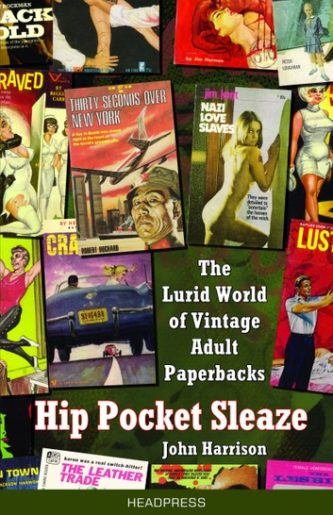 which may well turn out to be the bible for sleazy book connoisseurs. The author clearly knows the pulp book world in and out, providing a brief yet informative history of the paperback as well as a plethora of reviews and checklists of all sorts of sleazy publications. There’s coverage on James Herbert’s THE RATS, Charles Manson cash-ins and witchcraft exposes, as well as biker, JD, Nazi-sploitation and movie novelization paperbacks. There are interviews with the likes of lesbian pulp pioneer Ann Bannon, sci fi-porn specialist Richard E. Geis, trash fiction maestro Jim Harmon and even H.G. Lewis, in what as far as I know is the only interview devoted entirely to Lewis’ novelizations of BLOOD FEAST and TWO THOUSAND MANIACS. Rounding things out are chats with the paperback collectors Chris Eckhoff and Mariam Linna, whose tales of rare book finds had me seething with jealousy.
which may well turn out to be the bible for sleazy book connoisseurs. The author clearly knows the pulp book world in and out, providing a brief yet informative history of the paperback as well as a plethora of reviews and checklists of all sorts of sleazy publications. There’s coverage on James Herbert’s THE RATS, Charles Manson cash-ins and witchcraft exposes, as well as biker, JD, Nazi-sploitation and movie novelization paperbacks. There are interviews with the likes of lesbian pulp pioneer Ann Bannon, sci fi-porn specialist Richard E. Geis, trash fiction maestro Jim Harmon and even H.G. Lewis, in what as far as I know is the only interview devoted entirely to Lewis’ novelizations of BLOOD FEAST and TWO THOUSAND MANIACS. Rounding things out are chats with the paperback collectors Chris Eckhoff and Mariam Linna, whose tales of rare book finds had me seething with jealousy.
Harrison goes a bit off topic in the final chapters, devoted to non-book related subjects like 8mm porn loops and Adam Film World magazine. I’ll permit such indulgences, however, since the book overall is so impressive, illuminating as it does the grubbiest corners of the publishing world with considerable joy and panache.
WAR EAGLES: THE UNMAKING OF AN EPIC by DAVID CONOVER and PHILIP J. RILEY (Bear Manor Media) tells the story of the alleged “Greatest movie never made.” I believe that may be overstating the case, but 1939’s WAR EAGLES is a mighty intriguing piece of film history. It was conceived as a like-minded follow-up to KING KONG by that film’s creators Willis “Obie” O’Brien and Merian C. Cooper, but never made it to production. All that remains of WAR EAGLES are some conceptual drawings, production notes and a shooting script, all of which are reproduced here. Author David Conover carefully and minutely traces WAR EAGLES’ every surviving permutation, examining each piece of evidence and interviewing everyone he can find who had a connection with the production.
tells the story of the alleged “Greatest movie never made.” I believe that may be overstating the case, but 1939’s WAR EAGLES is a mighty intriguing piece of film history. It was conceived as a like-minded follow-up to KING KONG by that film’s creators Willis “Obie” O’Brien and Merian C. Cooper, but never made it to production. All that remains of WAR EAGLES are some conceptual drawings, production notes and a shooting script, all of which are reproduced here. Author David Conover carefully and minutely traces WAR EAGLES’ every surviving permutation, examining each piece of evidence and interviewing everyone he can find who had a connection with the production.
As for WAR EAGLES itself, it was to be a special effects packed epic about a daredevil pilot who in true KING KONG fashion happens upon a primitive land packed with dinosaurs. There he discovers a race of giant eagles that come in handy when a foreign power invades the US, leading to a very KING KONG-esque aerial showdown in the skies of NYC. All this is contained in the shooting script by Cyril Hume, which to these eyes read like KING KONG lite. So obviously I don’t quite share David Conover’s enthusiasm about WAR EAGLES, although I do admire his efforts at unearthing the particulars of this fascinating history.
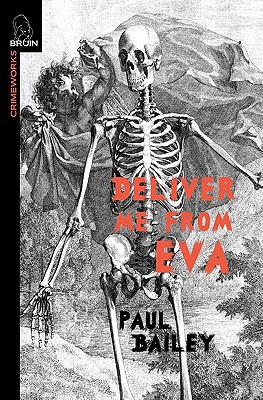 DELIVER ME FROM EVA by PAUL BAILEY (Bruin Books) is a recently interred 1946 pulp relic that, contrary to what you may have heard, is not a very good book (much less the “neglected classic” some have proclaimed it). It is engagingly nutty, however, being a fast moving and often (intentionally?) funny account of medical madness that plays like a Stuart Gordon movie set within a 1940s-era pulp framework.
DELIVER ME FROM EVA by PAUL BAILEY (Bruin Books) is a recently interred 1946 pulp relic that, contrary to what you may have heard, is not a very good book (much less the “neglected classic” some have proclaimed it). It is engagingly nutty, however, being a fast moving and often (intentionally?) funny account of medical madness that plays like a Stuart Gordon movie set within a 1940s-era pulp framework.
Mark Allard is a young lawyer who’s found blissful happiness (or so he thinks!) in his marriage with the seductive Eva. He’s a little nonplused, however, when Eva announces on their honeymoon that they’ll be living at Thalamus, her father’s Pasadena estate. Thalamus turns out to be an odd sort of place, presided over by Dr. Craner, a legless and earless dwarf who has found that by manipulating the bones of the spine he can untap all manner of latent human potential. Before long Mark is having to contend with a psychological “cycle” undergone by Eva during which she leaves the Earthly plain and an unholy brain experiment carried out by Dr. Craner, whose subject just happens to be Mark! All this is diverting enough, and concludes with a melee that leaves in its wake several corpses and no less than two severed heads.
Looking Forward…
As with every year, there are quite few intriguing 2013 publications I’m hotly anticipating, including…
NOS4A2 By JOE HILL: Get it? “Nosferatu?” I’ve no idea what this book is about but it’s by Joe Hill, which I believe should be recommendation enough for anyone.
UNUTTERABLE HORROR By S.T. JOSHI: Nobody alive knows more about horror lit than S.T. Joshi, and this two volume history of supernatural fiction promises to be the ultimate horror reference.
DOCTOR SLEEP By STEPHEN KING: The one and only SHINING sequel comes with a lot of advance hype. Let’s hope the novel, when it finally appears this fall, lives up!
THE RITUAL OF ILLUSION By RICHARD CHRISTIAN MATHESON: A new novella by the talented (if frustratingly unprolific) R.C. Matheson, who can usually always be counted on for good stuff.
STRANGE TALE OF PANORAMA ISLAND By EDOGAWA “RANPO”: From University of Hawaii Press, the first-ever English translation of an important novel by Japan’s Edogawa Rampo (here spelled with an N rather than M).
THE CITY OF THE STRANGE FEAR & OTHER TALES OF HARRY DICKSON By JEAN RAY: An Ex Occidente Press vetted collection by the incomparable Jean Ray that’s limited to just 100 copies—so if you’re interested you’d better act quickly!
THE CRAZY CORNER By JEAN RICHEPIN: A collection of self-proclaimed “Horrible Stories” by one of the masters of the 19th Century contes cruel school of horror fiction.
THE TUTU, MORALITY OF THE FIN-DE-SIECLE By “PRINCESS SAPPHO”: A “lost” 1891 novel, apparently “the most outrageous decadent novel ever penned. At once appalling and funny, it recognizes no taboos whatsoever…” Sounds intriguing, no?
